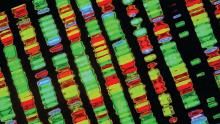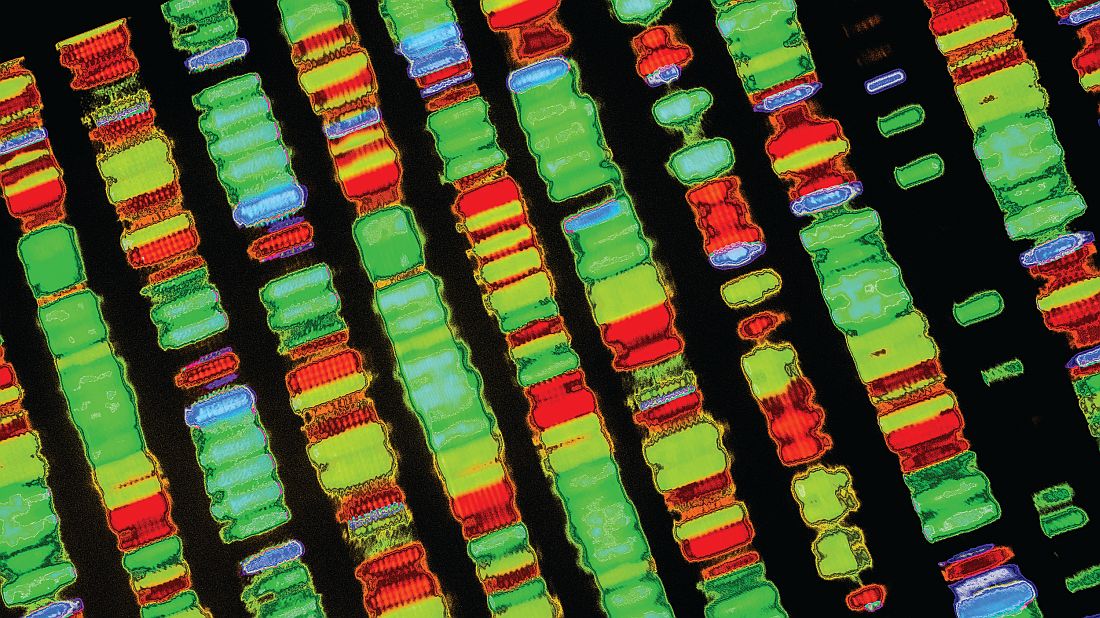User login
An updated Lynch syndrome (LS) prediction model improves accuracy and may be used to assess individuals who are currently unaffected by cancer. The model predicts an individual’s risk of carrying one of five known gene mutations associated with LS. It could be applied to individuals with a suspicious family history of cancer, as well as to colon cancer patients who may not have tumor immunohistochemical and microsatellite instability testing results that can spot potential LS patients based on specific tumor characteristics.
LS is linked to a 40%-80% lifetime risk of colorectal cancer and heightened risk of gynecologic cancer in women, as well as gastrointestinal, genitourinary, and additional cancers.
Addition of the PMS2 gene is important because there is some evidence that it is the most prevalent gene in LS, although it has a weaker phenotype, with cancer diagnoses at older ages and less striking family histories. Still, its higher frequency makes it an important player. “It’s a big deal. We originally thought the majority of LS was caused by MLH1 and MSH2 gene alterations, but that is no longer the case,” said lead author Fay Kastrinos, MD, MPH, director of the hereditary GI cancer risk and prevention program at New York–Presbyterian Hospital/Columbia University Medical Center.
The researchers recommend that anyone with a probability over 2.5% should be referred to evaluation for genetic testing, which could include germline genetic testing, microsatellite instability, or immunohistochemistry testing of a colorectal cancer tumor.
The new model is a successor to PRMM1,2,6, which evaluated a patient’s risk of a mutation in MLH1, MLH2, or MLH6. That model was developed from a population predominantly composed of colon cancer patients.
The researchers expanded the population for the PREMM5 model to include a total of 18,734 subjects who were evaluated for a wide range of clinical characteristics, as well as personal and family cancer history, and were tested for mutations in all five genes.
Of that population, 5% had mutations in one of the LS genes, and the model distinguished mutation carriers from noncarriers with an area under the curve of 0.81 (95% confidence interval, 0.79-0.82).
When the team applied the model to a validation cohort of 1,058 patients with colorectal cancer, it achieved a similar level of accuracy (AUC, 0.83; 95% CI, 0.75-0.92). When looking at the prediction of each specific gene, the model fared worse in predicting PMS2 mutations (AUC, 0.64; 95% CI, 0.60-0.68) than for other genes.
When applied to the PREMM5 development cohort, PREMM1,2,6 over-predicted mutation-positive status. (For MLH1, MSH2, and MSH6, it predicted a prevalence of 8.0%, compared with an observed frequency of 4.5%.)
Dr. Kastrinos stressed the potential use of the model among individuals unaffected by cancer. She noted that over 46% of the derivation cohort had no personal cancer history, only family histories of LS-associated cancers. “So, there is the potential for this model to be used in preventive health settings to assess familial cancer risk in someone who doesn’t have cancer but may be discovered to be at increased risk during a routine medical evaluation,” she said.
Gastroenterologists could also employ it with patients presenting for screening colonoscopy to assess for personal or family cancer history suggestive of LS. Patients ultimately found to have LS can be followed more closely, and close relatives can also be considered for testing. “If we can promote the identification of those with LS who are unaffected by cancer, we can make a tremendous impact in the prevention of malignancies associated with Lynch syndrome,” said Dr. Kastrinos.
Dr. Kastrinos reported having no financial disclosures.
An updated Lynch syndrome (LS) prediction model improves accuracy and may be used to assess individuals who are currently unaffected by cancer. The model predicts an individual’s risk of carrying one of five known gene mutations associated with LS. It could be applied to individuals with a suspicious family history of cancer, as well as to colon cancer patients who may not have tumor immunohistochemical and microsatellite instability testing results that can spot potential LS patients based on specific tumor characteristics.
LS is linked to a 40%-80% lifetime risk of colorectal cancer and heightened risk of gynecologic cancer in women, as well as gastrointestinal, genitourinary, and additional cancers.
Addition of the PMS2 gene is important because there is some evidence that it is the most prevalent gene in LS, although it has a weaker phenotype, with cancer diagnoses at older ages and less striking family histories. Still, its higher frequency makes it an important player. “It’s a big deal. We originally thought the majority of LS was caused by MLH1 and MSH2 gene alterations, but that is no longer the case,” said lead author Fay Kastrinos, MD, MPH, director of the hereditary GI cancer risk and prevention program at New York–Presbyterian Hospital/Columbia University Medical Center.
The researchers recommend that anyone with a probability over 2.5% should be referred to evaluation for genetic testing, which could include germline genetic testing, microsatellite instability, or immunohistochemistry testing of a colorectal cancer tumor.
The new model is a successor to PRMM1,2,6, which evaluated a patient’s risk of a mutation in MLH1, MLH2, or MLH6. That model was developed from a population predominantly composed of colon cancer patients.
The researchers expanded the population for the PREMM5 model to include a total of 18,734 subjects who were evaluated for a wide range of clinical characteristics, as well as personal and family cancer history, and were tested for mutations in all five genes.
Of that population, 5% had mutations in one of the LS genes, and the model distinguished mutation carriers from noncarriers with an area under the curve of 0.81 (95% confidence interval, 0.79-0.82).
When the team applied the model to a validation cohort of 1,058 patients with colorectal cancer, it achieved a similar level of accuracy (AUC, 0.83; 95% CI, 0.75-0.92). When looking at the prediction of each specific gene, the model fared worse in predicting PMS2 mutations (AUC, 0.64; 95% CI, 0.60-0.68) than for other genes.
When applied to the PREMM5 development cohort, PREMM1,2,6 over-predicted mutation-positive status. (For MLH1, MSH2, and MSH6, it predicted a prevalence of 8.0%, compared with an observed frequency of 4.5%.)
Dr. Kastrinos stressed the potential use of the model among individuals unaffected by cancer. She noted that over 46% of the derivation cohort had no personal cancer history, only family histories of LS-associated cancers. “So, there is the potential for this model to be used in preventive health settings to assess familial cancer risk in someone who doesn’t have cancer but may be discovered to be at increased risk during a routine medical evaluation,” she said.
Gastroenterologists could also employ it with patients presenting for screening colonoscopy to assess for personal or family cancer history suggestive of LS. Patients ultimately found to have LS can be followed more closely, and close relatives can also be considered for testing. “If we can promote the identification of those with LS who are unaffected by cancer, we can make a tremendous impact in the prevention of malignancies associated with Lynch syndrome,” said Dr. Kastrinos.
Dr. Kastrinos reported having no financial disclosures.
An updated Lynch syndrome (LS) prediction model improves accuracy and may be used to assess individuals who are currently unaffected by cancer. The model predicts an individual’s risk of carrying one of five known gene mutations associated with LS. It could be applied to individuals with a suspicious family history of cancer, as well as to colon cancer patients who may not have tumor immunohistochemical and microsatellite instability testing results that can spot potential LS patients based on specific tumor characteristics.
LS is linked to a 40%-80% lifetime risk of colorectal cancer and heightened risk of gynecologic cancer in women, as well as gastrointestinal, genitourinary, and additional cancers.
Addition of the PMS2 gene is important because there is some evidence that it is the most prevalent gene in LS, although it has a weaker phenotype, with cancer diagnoses at older ages and less striking family histories. Still, its higher frequency makes it an important player. “It’s a big deal. We originally thought the majority of LS was caused by MLH1 and MSH2 gene alterations, but that is no longer the case,” said lead author Fay Kastrinos, MD, MPH, director of the hereditary GI cancer risk and prevention program at New York–Presbyterian Hospital/Columbia University Medical Center.
The researchers recommend that anyone with a probability over 2.5% should be referred to evaluation for genetic testing, which could include germline genetic testing, microsatellite instability, or immunohistochemistry testing of a colorectal cancer tumor.
The new model is a successor to PRMM1,2,6, which evaluated a patient’s risk of a mutation in MLH1, MLH2, or MLH6. That model was developed from a population predominantly composed of colon cancer patients.
The researchers expanded the population for the PREMM5 model to include a total of 18,734 subjects who were evaluated for a wide range of clinical characteristics, as well as personal and family cancer history, and were tested for mutations in all five genes.
Of that population, 5% had mutations in one of the LS genes, and the model distinguished mutation carriers from noncarriers with an area under the curve of 0.81 (95% confidence interval, 0.79-0.82).
When the team applied the model to a validation cohort of 1,058 patients with colorectal cancer, it achieved a similar level of accuracy (AUC, 0.83; 95% CI, 0.75-0.92). When looking at the prediction of each specific gene, the model fared worse in predicting PMS2 mutations (AUC, 0.64; 95% CI, 0.60-0.68) than for other genes.
When applied to the PREMM5 development cohort, PREMM1,2,6 over-predicted mutation-positive status. (For MLH1, MSH2, and MSH6, it predicted a prevalence of 8.0%, compared with an observed frequency of 4.5%.)
Dr. Kastrinos stressed the potential use of the model among individuals unaffected by cancer. She noted that over 46% of the derivation cohort had no personal cancer history, only family histories of LS-associated cancers. “So, there is the potential for this model to be used in preventive health settings to assess familial cancer risk in someone who doesn’t have cancer but may be discovered to be at increased risk during a routine medical evaluation,” she said.
Gastroenterologists could also employ it with patients presenting for screening colonoscopy to assess for personal or family cancer history suggestive of LS. Patients ultimately found to have LS can be followed more closely, and close relatives can also be considered for testing. “If we can promote the identification of those with LS who are unaffected by cancer, we can make a tremendous impact in the prevention of malignancies associated with Lynch syndrome,” said Dr. Kastrinos.
Dr. Kastrinos reported having no financial disclosures.
FROM THE JOURNAL OF CLINICAL ONCOLOGY
Key clinical point: The researchers recommend testing for patients who score a probability greater than or equal to 2.5%.
Major finding: The model distinguished carriers from noncarriers with an AUC of 0.81.
Data source: Development cohort of 18,734 and validation cohort of 1,058.
Disclosures: No source of funding was disclosed. Dr. Kastrinos reported having no financial disclosures.

